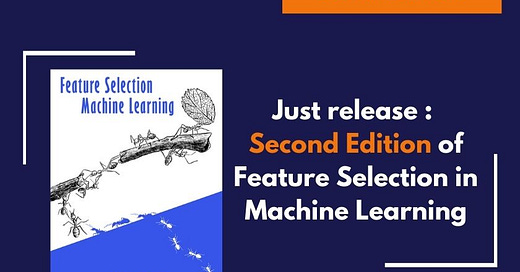Just released: 📣 Second edition of the book Feature Selection in Machine Learning 📣
Why a Second Edition? A Peek Behind the Curtain
Hey there!
I am very happy to share that I just released the second edition of my book Feature Selection in Machine Learning!
What's new?
I've added much more details, diagrams and discussions about every feature selection method, AND, included two new methods:
Feature selection using random probes
Maximum Relevance Minimum Redundancy (MRMR)
More good news:
👉 If you already bought the first edition, you can get the second edition at no extra cost! If you got the book on Leanpub or Train in Data, just head over there and download the new files.
👉 If you haven't got the book yet, this is a great time to do so:
We are offering a 20% launch discount until the end of this month.
Simply head over here to get the book, select the USD 24.99 price, and enter the coupon code SECONDEDITION2025 at checkout.
Offer is valid until 28th February 2025! Discount available only on Train in Data's website.
Behind the Scene of the Second Edition
Why now?
Last year, I released together with Packt the third edition of the Python Feature Engineering Cookbook. The book came a long way. The third edition is much better than the first and even the second edition, in that it has clearer and more concise explanations, highlighting advantages and limitations of each feature engineering method. In addition, I included more guidelines regarding which methods to use and when, and how they will impact the model and the data.
Motivated by the growth of the Python Feature Engineering Cookbook and by a series of new feature selection methods added to Feature-engine over the last few years.
What’s new in this second edition?
Even though the feature selection methods have not changed (why would they? They work great), I ended up re-writing a big part of the book. So, in this second edition, you'll find clearer and more concise explanations, and richer discussions about the advantages and limitations of each method, along with suggestions regarding when to use each method depending on the size and characteristics of your data and the machine learning model that you want to use.
I also re-organized the chapters: now there is a dedicated chapter to recursive feature elimination highlighting the value that this model brings respect to embedded methods and backward search.
In addition, I included two new feature selection methods: Selecting features with probes and MRMR.
How did I find out about the new methods?
I learned about probe feature selection from a talk by a Kaggle competitions master and then found that it had already been discussed by Isabelle Guyon in one of her great reviews on feature selection (if you haven’t read any of her articles, I suggest you do, they are like the bible of feature selection).
Google keyword tracker alerted me about MRMR: it was the fastest growing, most sought after term in 2024. In laywoman words, that means that a lot of people were searching for “MRMR” on the internet. So, I had to find out what it was about. And I did. And then I implemented it in Feature-engine. And now I added it in the book.
MRMR focuses on finding features that are highly related to the target but have little association with other features. It wants to maximise relevance and reduce redundancy among variables. The principle is solid. The implementation is good. The popularity came from it being used at Uber. Classy.
The tech behind the book
I used a different text editor to write the book: Quarto.
This was a suggestion I got from Christoph Molnar (the author of the Interpretable Machine Learning book). Migrating from Leanpub’s editor to Quarto was a bit of a pain at the beginning, because I had to edit the format of formulas, boxes, references and indexes to meet Quarto’s requirements. But it paid off in the long term.
Why? The book’s aesthetic: the new edition created with Quarto looks much nicer because it has colored boxes and code snippets. And the nicer it looks, the easier it is to read...
Where to get the book
Finally, I also migrated the book from Leanpub to Train in Data, so you can now find all of our products in one place and don't need to create extra accounts.
I really enjoyed the writing experience, and I truly hope you get a lot from this second edition of Feature Selection in Machine Learning, either if you are re-reading it, or starting from scratch.
Feedback from you
One last note: please do share your feedback, either by replying to this article, or even better, by sharing it on social media (you can tag me in all of these networks: LinkedIn, Twitter, Facebook, Bluesky, Insta) or leaving a review on Trustpilot.
I'll will appreciate that with all my heart ❤️
Thank you so much,
Sole
Ready to enhance your skills?
Our specializations, courses and books are here to assist you:
Advanced Machine Learning (specialization)
Forecasting with Machine Learning (course)





